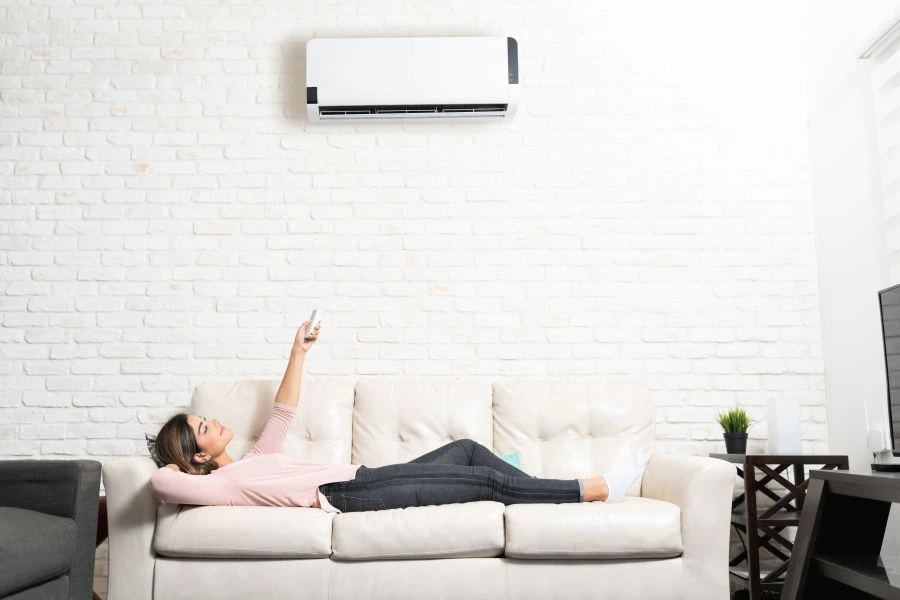
Air conditioning
Stay cool at lower cost
The weather is hot and you are dreading the electricity bill at the end of the month because of your air conditioning. Don't panic, we've prepared a guide of best practices to optimize the coolness of your home and save money. We teach you how to: identify the type of your air conditioner, the optimal power to keep your home cool, how to reduce the cost of your electricity bill, understand the sound volumes, and the maintenance of your device for a better use.

Types of air conditioners
Air conditioners can be stationary or mobile. Fixed devices require the installation of an air vent to evacuate hot air to the outside. In the same category, there are Split air conditioners made up of two parts, one located in the room to be air-conditioned, the other outside, again to evacuate the hot air. In both cases, the installation of such devices requires relatively significant work to be entrusted to a professional. This type of installation should be reserved for regions where the climate justifies regular seasonal use of air conditioning.
Split air conditioners can also be reversible. In this case, the device acts as a heat pump, and as a heater in winter.
To overcome the constraints related to the installation of a fixed air conditioning devices, one can turn to a mobile device. Less expensive to buy, these mobile appliances, which are often seen at the entrance to certain shops in summer, are perfect for benefiting from fresh air from time to time during an exceptional period of heat wave, but are not intended to be used all year round.
Mounted on wheels, they can be moved to the room of your choice during the day. Although mobile, they nevertheless require that the hot and humid air can be evacuated outside. This operation is done by means of a pipe to be placed in a window, or in a half-open door. You should know that this operation brings in the outside heat, so the ecological balance of mobile air conditioning is catastrophic. In order to reduce this negative ecological impact a little (and your electricity bill), the lesser evil is to use a window kit which guarantees a relative tightness of the hot and humid air evacuation. It can be a device to be placed on a half-open window, or which replaces, momentarily or not, one single pane of a window.
Which power to choose?
The wattage of air conditioners should be chosen according to the size of the room to be cooled. If the device is not powerful enough, it will spin longer and more often. In addition to premature wear of the equipment and an increase in noise, the electricity bill will clearly be affected!
With a ceiling height of 2.50 meters, for 10m², it takes 1kW. Most mobile devices have a power of 2000 to 3500 watts, so these are ideal for rooms of 15 to 40 m².
Save money
Air conditioners, like household appliances, are grouped into classes (A+++ to G) according to their electricity consumption. The information is present on the mandatory energy label. Choose a class device between A+++ and A at least.
When the device is equipped with a program such as eco mode or night mode, it is preferable to use it. In case of extended absence (more than one hour), a mobile device must be switched off. This is not a problem because mobile air conditioners can quickly cool the premises as soon as they are turned on, like a car air conditioner. On the other hand, you should not turn off a heat pump or an Inverter air conditioning (equipped with a particular type of power supply, not to be confused with reversible air conditioning).
The noise
Air conditioners are noisy devices since they have ventilation, it is in your best interest to take into account their noise level expressed in decibels (dB), also indicated on the energy label. A device below 50dB will be very discreet. Between 50dB and 60dB, you will hear it, but without it being a nuisance. Above 60dB, it will be really loud.
Also check the availability of a night mode, which enables you to reduce the ventilation power, if the device is left in operation during the night.


Usage tips
Mobile devices need to be installed not far from the door or window used to exhaust the hot and humid air, since the exhaust pipe cannot be longer than 3 meters.
Since temperature is also a matter of each individual perception, there is no need to lower it too much to immediately feel freshness. Between the outside and the inside, a difference of 5°C is more than enough. In any case, it is strongly advised not to exceed 7°C in order to avoid quickly catching a cold or sore throat.
To better withstand the heat, it is also important to maintain sufficient humidity in the room, between 40% and 60%. It is better for the body, but also for plants, pets, furniture and even musical instruments.
Maintenance
The filters of the devices must be regularly maintained, cleaned or changed, taking into account the manufacturer's information.
When the appliance is restarted after a long period of shutdown, it is advisable to operate its ventilation without cooling for one hour, in order to evacuate any humidity. The same operation must be carried out at the end of the season.



 Canada (English)
Canada (English)  México (Español)
México (Español)  USA (English)
USA (English)  América Central y el Caribe (Español)
América Central y el Caribe (Español)  Argentina (español)
Argentina (español)  Bolivia (español)
Bolivia (español)  Chile (español)
Chile (español)  Colombia (español)
Colombia (español)  Equador (español)
Equador (español)  Deutschland (Deutsch)
Deutschland (Deutsch)  France (Français)
France (Français)  Nederland (Nederlands)
Nederland (Nederlands)  United Kingdom (English)
United Kingdom (English)